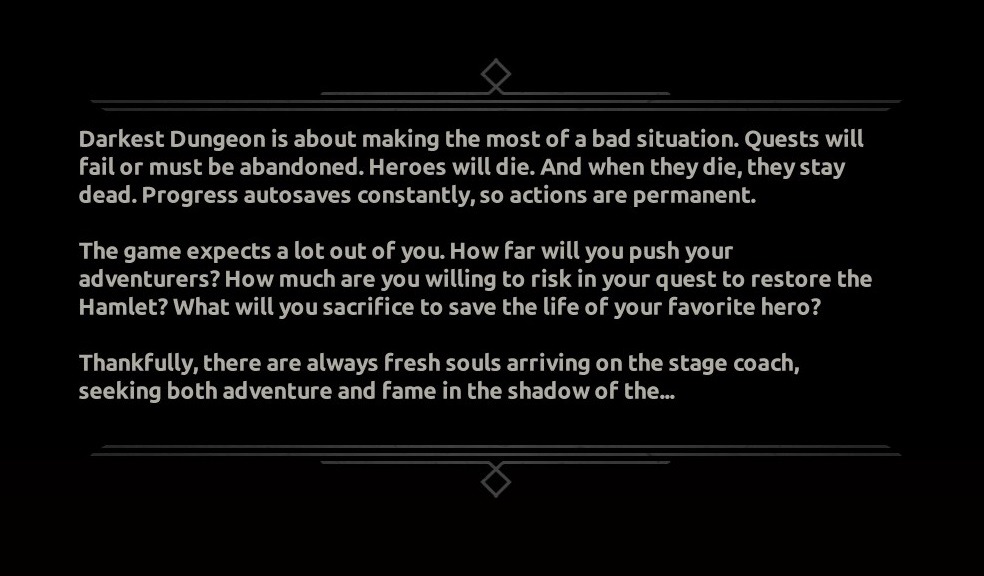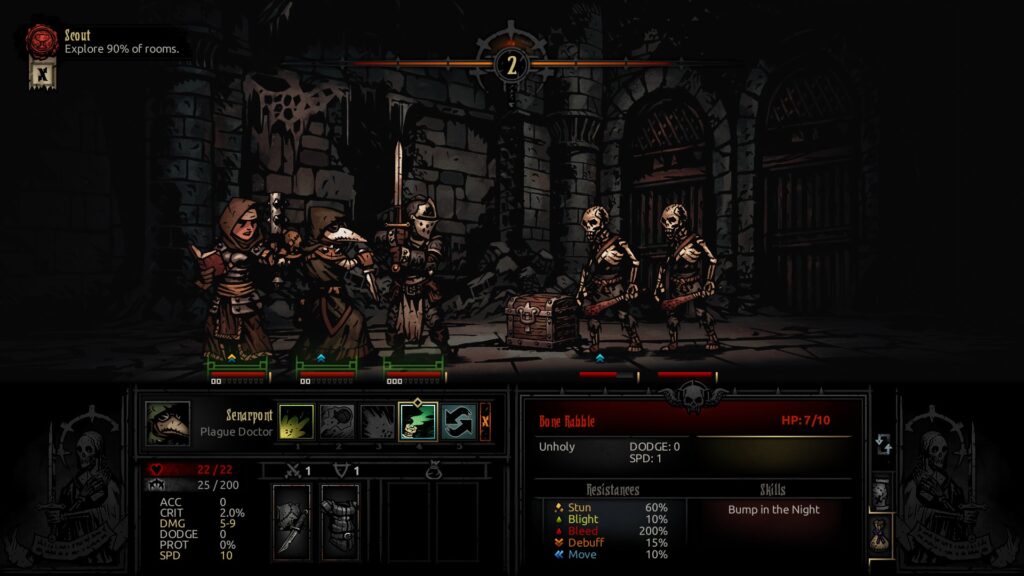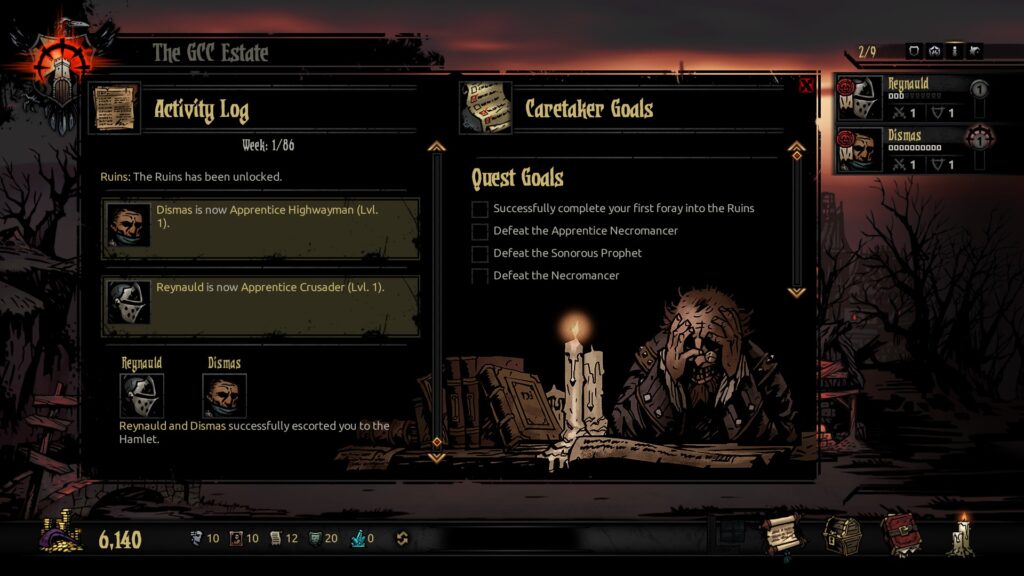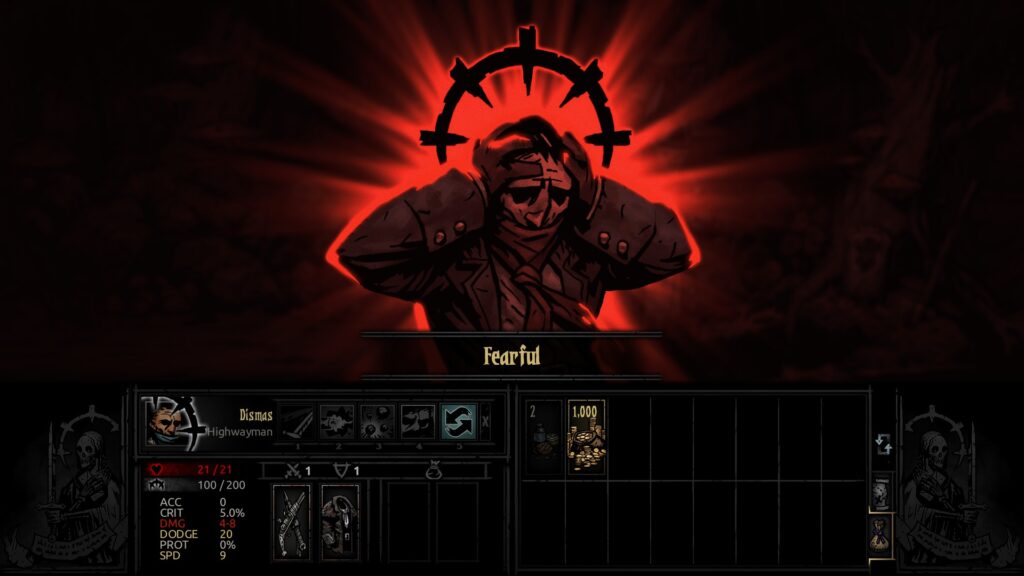October, that wonderful time of year when the weather starts to cool and scary movies start to pop up on television and on the main page of streaming services! To celebrate this month and the upcoming Halloween holiday, I have decided to take a look at some games in the horror genre. This time I will be taking a look at Darkest Dungeon a dark fantasy role-playing game released by Red Hook Studios in 2016.
I usually don’t comment on the studios themselves, other than to note when one is independent, but I did find it amusing that the Red Hook Studios web-site address was actually RedHookGames.com. I was also disappointed to learn that they are based in Canada, and not New York. Anyhow, onto the game!

In Darkest Dungeon you take up the role of the inheritor of a crumbling gothic estate. Your Ancestor, as he is titled throughout the game, sank the family fortune into excavating the ruins beneath the manor. He unearthed a gate that released monstrous horrors, which would be at home in a H.P. Lovecraft story, upon the land.
Even though he survived this initial encounter, it was too much for his mind. Before taking his own life, he wrote you a letter about these events, begging you to return and redeem your family. The game then picks up with you traveling by stagecoach through the bandit-infested woods outside of the estate.

The gameplay in Darkest Dungeon involves you controlling a party of 1 to 4 heroes as they battle their way through this accursed land. Dungeons are made up of rooms connected by hallways, with the simplest example being two rooms connected by a corridor found in the initial tutorial stage. You can see the dungeon map in the bottom right corner of the screen.
Your party moves through the dungeon, exploring the halls between each room. Each hall has four sections, and each section may contain monsters, traps, or an object – referred to as a curio in documentation about the game. Curios can be a variety of things, from chests that contain items to obstructions that need to be cleared away.

The rooms themselves can also contain monsters, treasure and monsters, or quest objectives in some dungeons. Speaking of objectives, each dungeon has some sort of goal that you need to finish in order to complete the dungeon. You do also have the option to flee back to town if things aren’t going well.

The overall goal of the game is to clear the areas surrounding the estate, and then venture into the Darkest Dungeon that lies under it. Technically, you can jump right into the Darkest Dungeon, but without gearing up and leveling up your heroes first that would be suicidal. You can find a list of quest goals for the game in town, along with the daily activity log.
Outside of the titular Darkest Dungeon, there are four other areas in the core game: the Ruins, the Weald, the Cove, and the Warrens. Each area has its own set of monsters and objects, though there are also a few that can appear in multiple areas. When first starting the game, you only have access to the Ruins. Bosses will also appear after a certain number of missions have been completed within an area.

Individual mission objectives are typically either to defeat all monsters in a dungeon or to explore a certain percentage of the rooms. Aside from defeating bosses, the other two missions that may come up are to gather a certain number of quest items or to discover and activate a certain number of curios in the dungeon.
Missions can also vary in duration, from short to medium to long, and in difficulty, from Apprentice (level 1) to Veteran (level 3) to Champion (level 5). In longer missions, your party may need to rest overnight, which may allow your heroes to recover or gain bonuses for the upcoming day. The party may also be attacked while resting.

Heroes come in an assortment of classes, more than a dozen, each with seven combat skills and seven camping skills. Typically, a hero will only start with 4 of 7 combat skills available and the others can be unlocked in town at the Guild. Camping skills provide bonuses when resting in longer dungeons. Heroes start with 3 and the others can be unlocked in town at the Survival Camp.
You start the game with Dismas the Highwayman and Reynauld the Crusader. You can then recruit more randomly generated heroes from the Stage Coach. The number available depends upon how much you have upgraded the Stage Coach.

All of the buildings in town can be upgraded using items called Heirlooms, which are treasures found in dungeons or rewards for successfully completing missions. Aside from the already mentioned buildings, there is a Blacksmith where you can upgrade heroes’ weapons and armors by spending gold. There is a Nomad Wagon where you can buy trinkets.
Trinkets provide statistical bonuses to heroes. Each hero can equip a maximum of two. Trinkets can also be found in dungeons, or as rewards for completing missions.

There are two buildings in town that help heroes recover from the horrors of the dungeon, the Abbey and the Tavern. In Darkest Dungeon heroes have both Health and Stress as stats. When health drops to zero, they may die if they take additional damage.
However, if Stress rises to 100, half of the 200 total, they will either become Afflicted or Virtuous. If they are Afflicted, as seen below, they become a major liability. That hero will sporadically gain further Stress, as well as cause other party members to gain Stress. Afflicted heroes may also refuse to participate in combat or use random skills instead of letting you choose their actions.

If a hero becomes Virtuous, they lose Stress and gain other buffs. If a hero reaches 200 Stress, they die if they are not in a Virtuous state. If a hero in a Virtuous state hits 200 stress, they simply lose the buff and go back to 0 Stress.
The final building is the Sanitarium. Heroes can be impacted more permanently by their dealings with the horrors of the dungeons and can gain Quirks. Quirks are essentially buffs/debuffs related to some mental trauma. These can be cured at the Sanitarium, or made permanent if they are beneficial.

Combat is fairly straightforward on the surface, though requires a bit of planning to try to make the best of the resources available to you. Hero and monster abilities may only be usable from certain positions in the party order, i.e. melee classes may only be effective at the front of the party. Some classes also have healing for health or stress reduction, either for themselves, the party, or any single party member.

Suffice to say, there’s a lot that could be said about the strategy for this game. Even this, not quite brief, overview just touches on the basic mechanics of the gameplay. This isn’t meant to be an in-depth strategy article, so let’s move on to the quality of the game.
The art has a dark, comic book style, that I feel is quite appropriate for the gothic horror mood that they seem to be going for in the game. The music, sound effects, and voice-over narration are all extremely well done. This is not just my opinion, the game was nominated for several awards relating to the art and audio.

The gameplay can be quite punishing. Darkest Dungeon auto saves, so you can’t just reload if you make a mistake. There are three difficulty settings, and I would personally recommend trying the easiest until you learn the game. On the hardest difficulty you have a set amount of days before you lose automatically, and if too many heroes die you lose.
The difficulty is part of the charm of the game for some people. Actually making progress feels like you’ve achieved something, rather than simply reloaded from a save until a fight went your way. Just be aware of what you are getting into when challenging the Darkest Dungeon.

Overall, I would give the game an “A”, or 9.5/10 stars. I personally really enjoy the genre, and it is executed quite well. The developers have also added the ability to do mods for the game, from characters, to items, and monsters.
It isn’t what I would consider a scary game, but it’s certainly not appropriate for small children. If you want to check out Darkest Dungeon, it is available on Steam here, and it currently has a Very Positive rating on this platform.